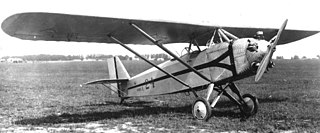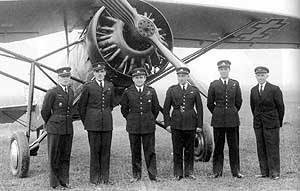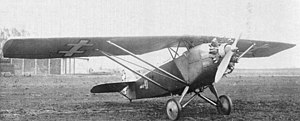The Aero A.204 was a Czechoslovakian airliner that flew in prototype form in 1936. It was developed specifically for ČSA, but much to Aero's surprise and disappointment, the national airline selected a British product instead, the Airspeed Envoy. Unable to find a customer, Aero began to develop a military version instead, as the A.304.

The ANBO IV was a reconnaissance aircraft used by the Lithuanian Air Force in World War II, designed by Lithuanian aircraft designer Antanas Gustaitis. The Lithuanian ANBO 41 was far ahead of the most modern foreign reconnaissance aircraft of that time in structural features, and most importantly in speed and in rise time. All ANBO 41 aircraft were likely destroyed during World War II.

The ANBO I was a single-seat aircraft developed in Lithuania, proposed as a trainer for the Army It was a low-wing, braced monoplane of conventional tailwheel configuration. The fuselage structure was of fabric-covered welded steel tube, The wing had a wooden, two-spar structure and was fabric covered but the fuselage, also fabric covered, had a welded steel tube structure.

The ANBO II was a parasol-wing monoplane aircraft built in Lithuania in 1927 as a pilot trainer for the Army. It was eventually reequipped with more powerful engine for the Aero Club of Lithuania in 1931 before being written off in a crash in 1934.

The ANBO V was a parasol wing monoplane training aircraft designed for the Lithuanian Army in 1931. A developed version, the ANBO 51 followed in 1938.

The DAR 6 was a 1930s Bulgarian two-seat basic or advanced biplane training aircraft.

The Fairchild 22 Model C7 was an American two-seat touring or training monoplane designed and built by the Kreider-Reisner division of the Fairchild Aircraft Corporation at Hagerstown, Maryland.
The SET 10 was a trainer aircraft produced in Romania in prototype form in the early 1930s. It was a conventional, single-bay biplane with staggered wings braced with N-struts. It was equipped with fixed tailskid undercarriage, and seated the pilot and instructor in tandem, open cockpits. Intended for Romania's aeroclubs and Air Force, no production ensued.

The Peyret-Mauboussin PM XI was a French high-wing touring aircraft of the early 1930s.

The Letov Š-50 was a 1930s prototype Czechoslovakian military general-purpose monoplane, designed and built by Letov.

The ANBO VIII was a Lithuanian bomber-reconnaissance monoplane designed by Antanas Gustaitis and built by Karo Aviacijos Tiekimo Skyrius.
The ANF Les Mureaux 140T was a French postal monoplane first flown in September 1932. It was a high-wing monoplane powered by three 120 hp (89 kW) Salmson 9Ac radial engines. It had room for six passengers or four plus freight or mail but it did not enter production.
The Kadiak KC-2 Speedster is an American single-seat, radial engined homebuilt biplane designed prior to World War II.
The Redfern Nieuport 17/24 is an American homebuilt aircraft that was designed by Walter Redfern and produced by the Walter Redfern Company of Post Falls, Idaho, based upon the First World War Nieuport 17 and Nieuport 24 fighter aircraft. When it was available the aircraft was supplied in the form of plans for amateur construction.

The Potez 40 was a French three-engine, braced high-wing monoplane designed and built in response to a French government programme for colonial transport and policing aircraft duties.

The Delanne 11 was a French two seat touring aircraft. Only one was built.
The Peitz 101, aka Peitz Avionette, was a French, amateur-built, all-metal light aircraft, first flown during the winter of 1931–32.
The Potez 42 was designed and built in 1930 to meet a French government requirement for a small air ambulance capable of operating in the colonies. It did not reach production.

















